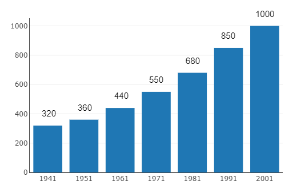
Draw a bar graph for the following data.
The population of India in successive census years.
Year 1941 1951 1961 1971 1981 1991 2001 Population (in millions)(approx.) 320 360 440 550 680 850 1000
| Year | 1941 | 1951 | 1961 | 1971 | 1981 | 1991 | 2001 |
| Population (in millions)(approx.) | 320 | 360 | 440 | 550 | 680 | 850 | 1000 |
Answer
557.7k+ views
Hint: For drawing the graph we take the years on X-axis and population on Y-axis. By assuming some scale to both the axes we plot the graph in rectangles each year, which means we take ten years as one unit which will be the breadth of the rectangle and the population as the length of the rectangle.
Complete step-by-step answer:
Let us assume the years on X-axis and the population on Y-axis.
Now, let us create a table extending the given data to one column of having the coordinates of points to be represented on the graph as follows
Now, let us take the scale.
On X-axis 1 unit is equal to 10 years and on the Y-axis 1 unit is equal to 200 million.
By using this scale let us plot the bar graph of the given data.

Hence, the bar graph of the given data is drawn.
Note: Students may miss some points that are listed below.
We need to draw a bar graph in rectangles, not as points.
After drawing the rectangles, we have to give some color or design or some shading to the rectangles to avoid confusion.
Mention corresponding Y-axis values on the rectangles to avoid confusion.
The years need to be taken in the range which means we take the same population over the decade because it is a bar graph.
Complete step-by-step answer:
Let us assume the years on X-axis and the population on Y-axis.
Now, let us create a table extending the given data to one column of having the coordinates of points to be represented on the graph as follows
| Year | Population (in millions) | Co-ordinates |
| 1941 | 320 | (1941, 320) |
| 1951 | 360 | (1951, 360) |
| 1961 | 440 | (1961, 440) |
| 1971 | 550 | (1971, 550) |
| 1981 | 680 | (1981, 680) |
| 1991 | 850 | (1991, 850) |
| 2001 | 1000 | (2001, 1000) |
Now, let us take the scale.
On X-axis 1 unit is equal to 10 years and on the Y-axis 1 unit is equal to 200 million.
By using this scale let us plot the bar graph of the given data.

Hence, the bar graph of the given data is drawn.
Note: Students may miss some points that are listed below.
We need to draw a bar graph in rectangles, not as points.
After drawing the rectangles, we have to give some color or design or some shading to the rectangles to avoid confusion.
Mention corresponding Y-axis values on the rectangles to avoid confusion.
The years need to be taken in the range which means we take the same population over the decade because it is a bar graph.
Recently Updated Pages
Master Class 8 Maths: Engaging Questions & Answers for Success

Class 8 Question and Answer - Your Ultimate Solutions Guide

Master Class 7 Maths: Engaging Questions & Answers for Success

Class 7 Question and Answer - Your Ultimate Solutions Guide

Master Class 6 Maths: Engaging Questions & Answers for Success

Class 6 Question and Answer - Your Ultimate Solutions Guide

Trending doubts
What is meant by exothermic and endothermic reactions class 11 chemistry CBSE

Which animal has three hearts class 11 biology CBSE

10 examples of friction in our daily life

One Metric ton is equal to kg A 10000 B 1000 C 100 class 11 physics CBSE

1 Quintal is equal to a 110 kg b 10 kg c 100kg d 1000 class 11 physics CBSE

Difference Between Prokaryotic Cells and Eukaryotic Cells




